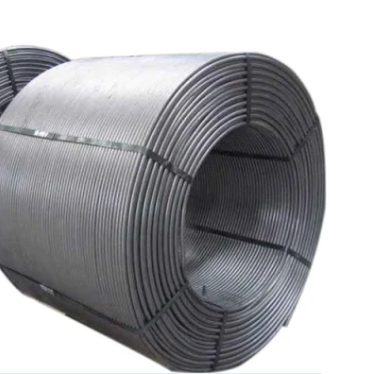
Calcium cored wire is a vital tool in the steelmaking industry, valued for its versatility and effectiveness in various applications. This article aims to provide a comprehensive overview of the diverse uses of calcium cored wire, highlighting its significant contributions to the steel manufacturing process.
One of the primary uses of calcium cored wire is desulfurization in steel production. The presence of sulfur in molten steel can lead to brittleness and reduced mechanical properties. Calcium cored wire introduces calcium into the molten steel, forming calcium sulfide (CaS), which floats to the surface and is easily removed as slag. This process helps achieve lower sulfur content in the final steel product, enhancing its quality and performance.
Calcium cored wire is widely employed for deoxidation purposes in steelmaking. During the steelmaking process, oxygen can react with molten steel and form unwanted oxides. Calcium cored wire releases calcium vapor when added to the melt, which reacts with oxygen to form calcium oxide (CaO) or calcium aluminate (CaAl2O4). These oxides then float as slag, leading to improved steel cleanliness and reduced reoxidation.

The addition of calcium cored wire aids in inclusion modification, which refers to the control and modification of non-metallic impurities present in steel. Calcium reacts with oxygen, sulfur, and other impurities, forming compounds that can be effectively removed during the refining process. Inclusion modification improves the steel's mechanical properties, ductility, and resistance to fatigue and corrosion, resulting in higher-quality end products.
Calcium cored wire is also used for alloying purposes in steelmaking. By incorporating calcium-based alloys into the steel melt, desired alloying elements, such as calcium-silicon (CaSi) or calcium-manganese (CaMn), can be introduced. These alloying elements enhance specific properties of the steel, such as strength, hardness, and corrosion resistance, catering to different industry requirements.
Microalloying, the addition of small amounts of specific elements to steel, is another application of calcium cored wire. Calcium-based microalloying wires, containing elements like boron, titanium, or niobium, are used to refine the grain size and control the precipitation of certain phases during solidification. This technique improves the mechanical properties of the steel, allowing for lighter and stronger products.
Apart from its role in the steelmaking process, calcium cored wire is used for calcium treatment of molten aluminum. The addition of calcium to liquid aluminum removes impurities, enhances the metal's fluidity, and reduces the occurrence of casting defects. This treatment is crucial in industries such as automotive manufacturing, where high-quality aluminum components are required.
Calcium cored wire plays a multifaceted role in the steelmaking industry, offering a range of benefits in desulfurization, deoxidation, inclusion modification, alloying, microalloying, and calcium treatment. Its versatility and effectiveness in enhancing steel quality, improving mechanical properties, and meeting industry demands make it an indispensable tool in modern steel production. By harnessing the power of calcium cored wire, manufacturers can produce high-performance steel products that meet the diverse needs of various applications.

Write a Message